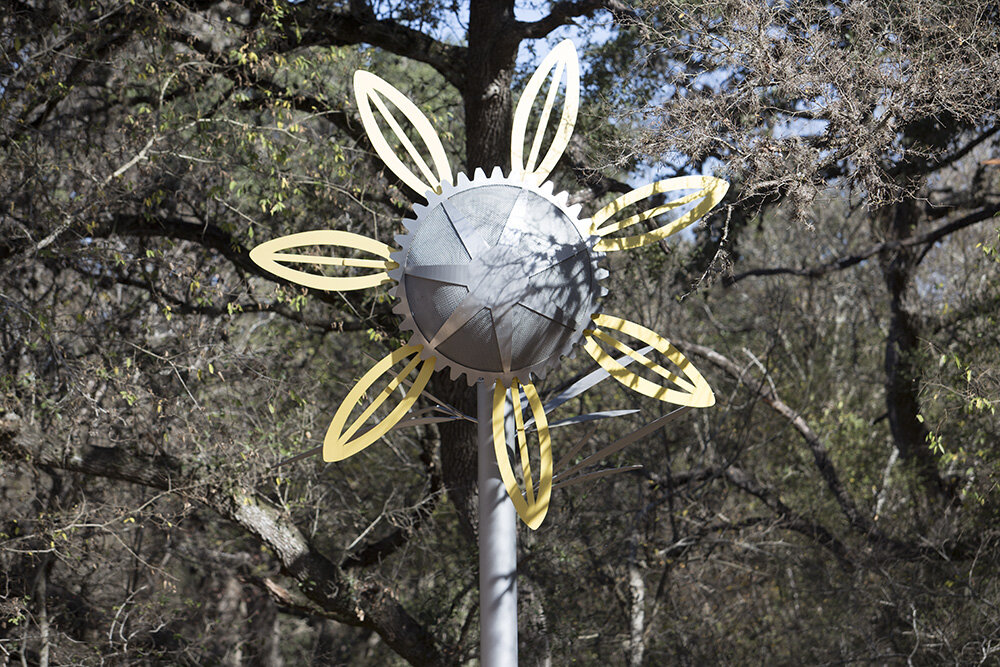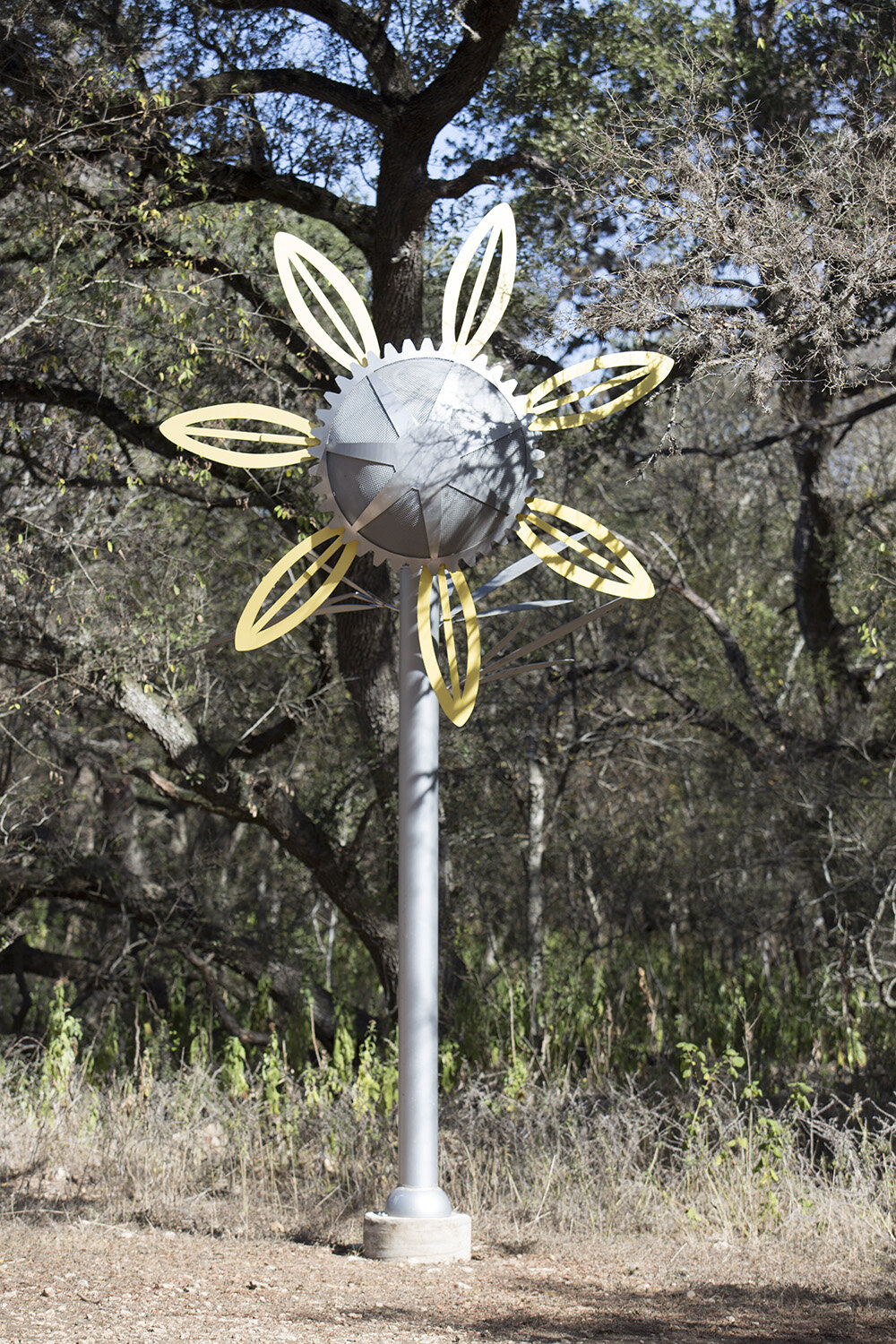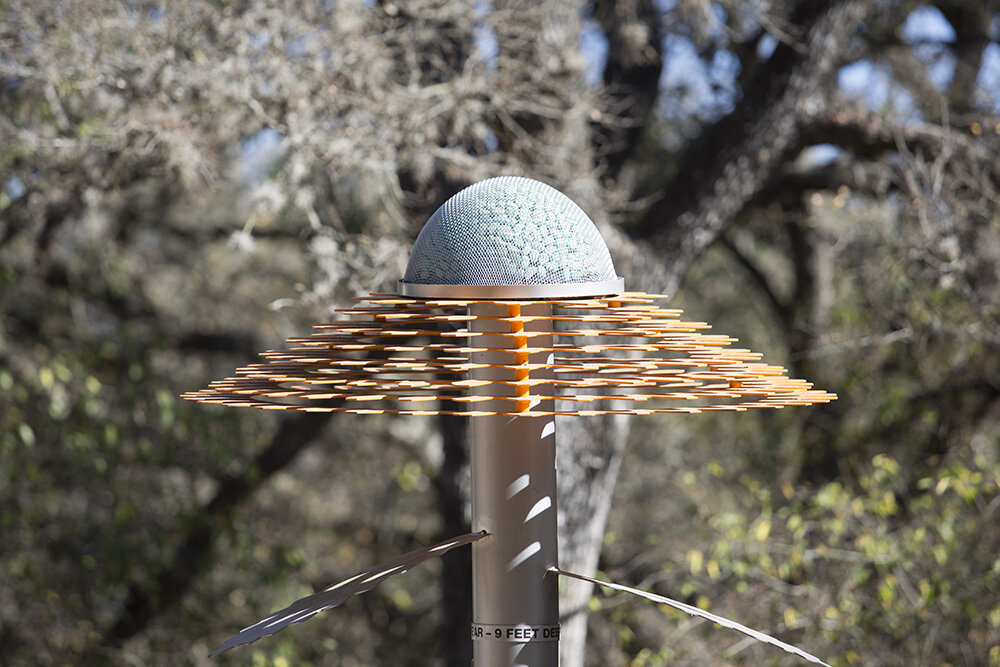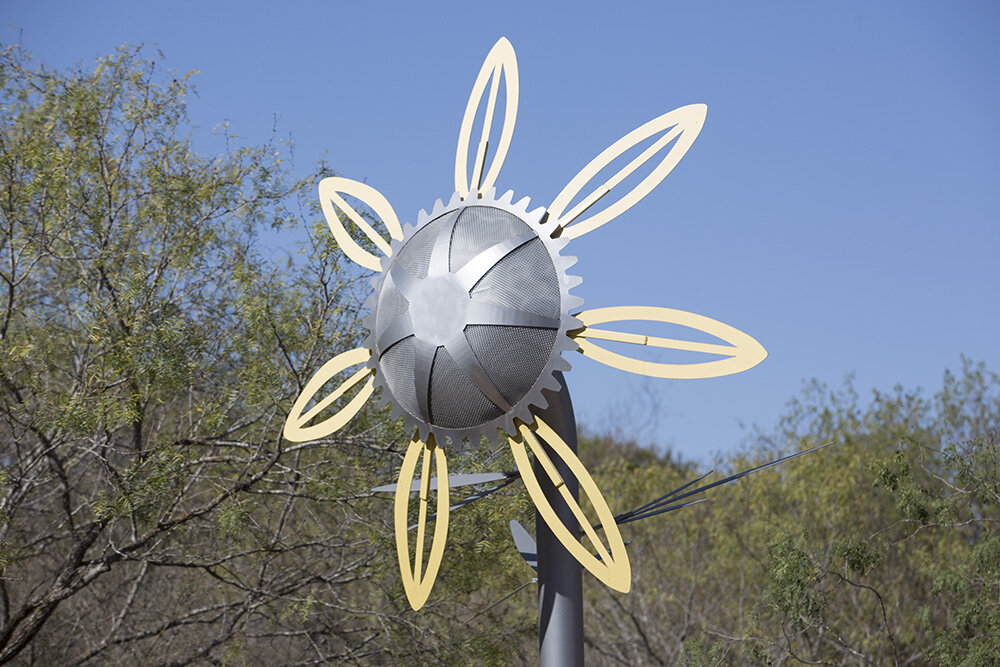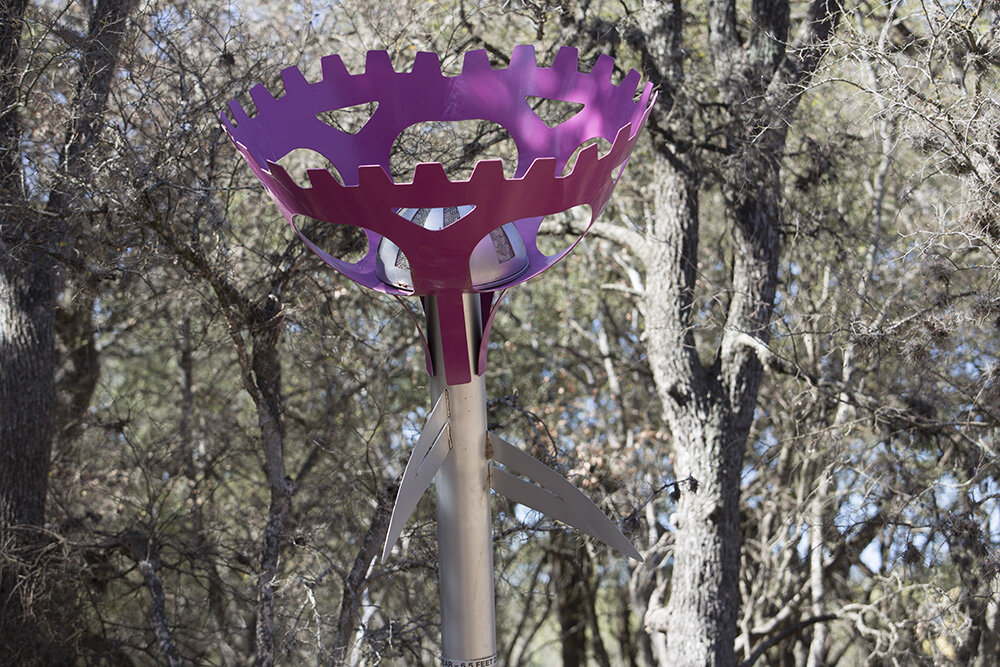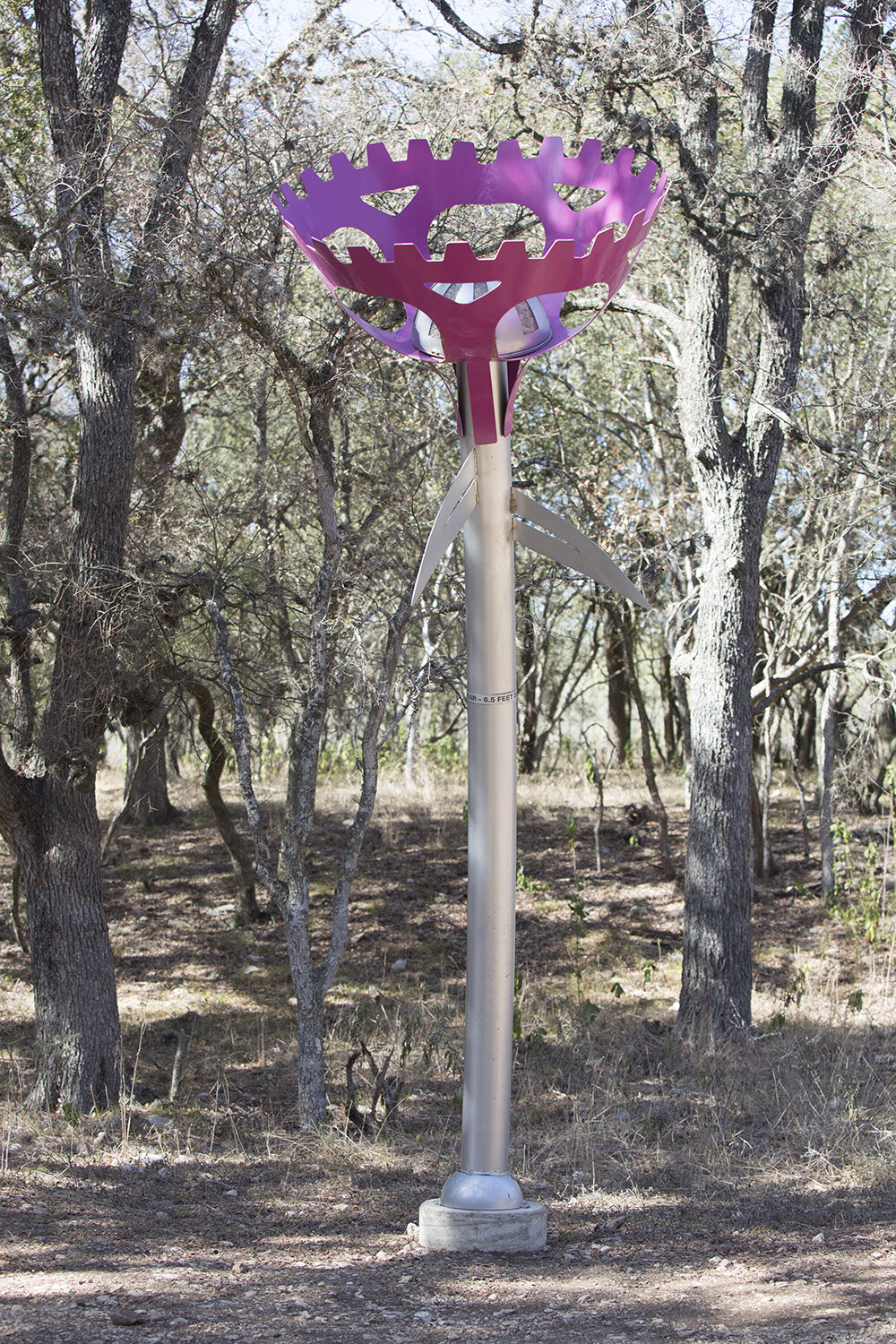Public Artist Leticia Huerta Continues to Flourish Across City Parks
Public artist Leticia Huerta will debut a continuation of “Bloom” across parks in San Antonio. The pieces are to be finished by June of 2022. Photo Gallery by B. Kay Richter.
November 25, 2020 - San Antonio
By: Valeria Torrealba - Staff Intern, San Antonio Sentinel
With a successful 2018 debut, “Bloom” public artist Leticia Huerta will continue to plant her mesmerizing and gigantic steel flowers across public parks in San Antonio. Originally planted at the Mud Creek Loop in McAllister Park, the flowers were well-received by the community, further inspiring Huerta to continue with the project with Public Art San Antonio (PASA).
“Park visitors took to them right away,” said Debbie Racca-Sittre during an interview with the Express-News. As the director of the city’s Department of Arts and Culture, she also said it would take a few years for the new statues to be installed.
The steel flowers represent just how much nature surrounds everyday lives. Huerta’s craft involves taking inspiration from bicycle parts and welding them to become beautiful, eccentric flowers in partnership with Wanderlust Ironworks, LLC.
“As soon as they went up, they were very popular,” Huerta said during a phone interview with the Sentinel. “I would get pictures of people playing around them. They approached me about doing more of these at other park locations — a lot of them tied to the walking trail — so I’m continuing the same idea, because these trails are also about biking.”
When asked about her creative process, Huerta described the mindlessness of it — how her art just takes form and takes over, honing her passion for nature and biology in intricate pieces.
“I look at the bicycle, all the different little gears and a lot of the little parts associated with them. I didn’t know the names of a lot of them, but you don’t really think about it. The shapes of the bicycle, wheel, everything is organic-looking — to me, they kind of refer to nature. It was easy to take those parts and turn them into flower petals, the centers of the flowers — it all just became so relatable.”
Public art was the vessel for Huerta’s staple across the city — with a degree in biology, her love for nature was nurtured through her flowers, marking a passion for maintaining the environment pure and safe.
“I always sort of regretted not becoming a biologist and working on the environment, and I think that that love of nature and feelings of what’s happening to our environment keeps me going back to it. It’s sort of a healing place — wanting to say something about [nature], yet I didn’t do that in my life — I feel like I’m doing it now with my artwork and celebrating it, and not forgetting it is the most important part of our lives.”
“ I look at the bicycle, all the different little gears and a lot of the little parts associated with them. I didn’t know the names of a lot of them, but you don’t really think about it. The shapes of the bicycle, wheel, everything is organic-looking — to me, they kind of refer to nature. “ - Leticia Huerta
Huerta’s public art continues to be a staple across the city — with a degree in biology, her love for nature was nurtured through the creation of her flower installations. Photo: B. Kay Richter.
The threat of climate change has grown exponentially across the globe. With each summer getting warmer and winters resembling heat deserts in Texas, the conversation regarding humanity’s care of the earth arises. For Huerta, the desire to maintain the environment healthy and stable has followed her through her work — both in art and the biology field.
“The environment is really one of the most important things that we have to take care of. [My art] is also a reminder of that. It’s not a process I think about consciously, it’s a process that’s always been there for me. I always seem to go back to it in all my work. It’s a natural sort of process that just happens. I don’t fight it anymore — I tried to do other things — that’s where my interest is in, and it’s the most honest part of my work.”
Huerta’s flowers represent not just nature, but the hands that it is put in: our own. Although delicate and subtle, Huerta channels her own concerns about climate change and the speed at which the environment deteriorates due to waste.
“I do feel that climate change is real, and we’re creating the means for that to happen,” Huerta said. “In my own studio work, I did a lot of recycling. Cans, anything, really that I could find. With these pieces, I have WanderLust Ironworks that do the fabrications for me. There is this element of the manmade and nature, hand-in-hand, that we were instrumental in destroying nature. Hopefully, we can be instrumental in bringing it back by the use of our scientific discoveries and what we can do now to turn that around. It’s kind of a marrying of the two — of nature and mankind — so that we can work together to hopefully not destroy ourselves.”
The marriage of man-made art and nature provides a hopeful message: climate change can be reversed. Mankind is capable of doing fantastic things across the globe — honoring nature and combining the two is Huerta’s goal and message with her flowers.
“To me, it’s about something that’s manmade, but at the same time about nature,” Huerta said. “It’s a partnership that I hope we can get to. There’s an element of that, that we’re speaking about that and yet we’re using something that is totally manmade — the sculpture, the steelwork, the welding — all of that that has really not much to do with nature, but yet it can be used to make a beautiful rendition of it, to celebrate it, to remind us that we don’t wanna lose this. I feel like I’m doing my part to talk about that, even if it’s in a subtle way. It reminds us how beautiful [the environment] is and how we need to share and take care of it.”
Huerta’s flowers are scheduled to pop up at South Side Lions Park on January of 2022 and, eventually, at the Tezel Road Community Facility on June 2022.
Valeria Torrealba is an opinions columnist and public relations assistant at the University Star, a student publication of Texas State University. Email her at reporter@sasentinel.com

